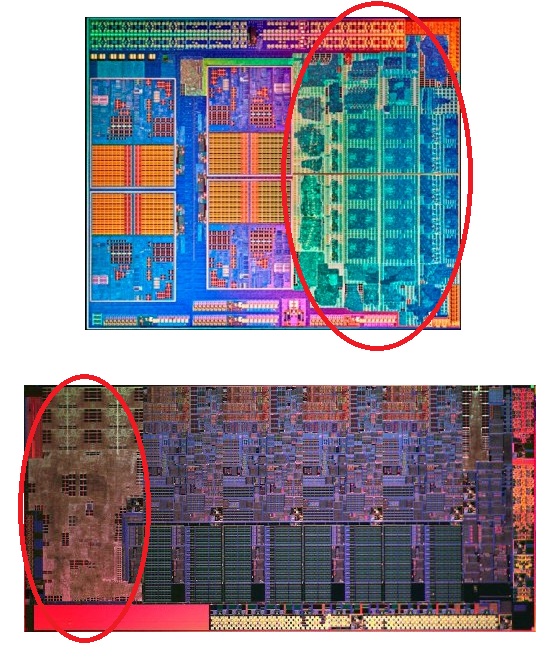AMD A8-3850 : An HTPC Perspective
by Ganesh T S on June 30, 2011 6:20 AM ESTPresent day consumers use their PCs for multimedia intensive tasks such as HD video playback. These HTPC tasks are not very power efficient when done using the x86 processor alone. Gamers have remained the main focus of the GPU developers. However, the GPU architecture (coupled with a dedicated video decoder on the same silicon) is quite useful for video playback and post processing also. This lightens the load on the x86 processor, and so, even consumers who rarely game opt to go for a discrete HTPC graphics card.
Intel used to integrate the GPU into the chipset till the GMA X4500. In Clarkdale, the integrated GPU became a part of the processor package itself, and eventually became a part of the main die in Sandy Bridge. The GMA X4500 and later models have a very efficient decoder, and renders a discrete HTPC graphics card redundant for most entry level users. AMD, unfortunately, had support for integrated graphics in only some of their chipset models. That is set to change today, as Lynx (the desktop version of the Llano) makes its way into the market. Ever since AMD acquired ATI, a processor with AMD's x86 CPU and ATI's GPU on the same die was hotly expected. The Lynx integrates a number of AMD Stars cores and also an updated Redwood class GPU (called Sumo) into the same die.

GPU Area in the Llano vs. GPU Area in Sandy Bridge (Die shots approximately to scale)
GPU support for basic HD video decoding and the 3D fad (Blu-rays) is provided by all the current platforms from Intel, AMD and NVIDIA. From an HTPC perspective, mainstream consumers have started feeling the need for good, flexible video post processing capabilities also. Discrete AMD GPUs are well respected in the HTPC community, and the Redwood class GPUs have been used to override the Clarkdale's IGP in many a setup. Can the Sumo wrestle the spot away from Intel HD3000 Graphics in HTPCs?










104 Comments
View All Comments
Galcobar - Friday, July 1, 2011 - link
Well, if Anandtech is so deeply in Intel's pocket, Intel might want their money back if the corporation were to read all the accusations of bias against Intel SSDs when Anandtech reviews an OCZ drive and concludes it's faster if less reliable.Well, as my journalism profs said, if everyone's angry at you, you're doing your job.
Musafir_86 - Friday, July 1, 2011 - link
Hi Ganesh,-Thanks for the article. As per your reply to me in the preceding article (by Anand), besides video quality, where are the comparison for gaming? Or am I wrong to expect image quality (IQ) comparison for 3D games here?
Thanks again.
ganeshts - Friday, July 1, 2011 - link
I misunderstood your original request for IQ testing. I thought it was for video playback.As for 3D games, I am not the right person since I don't play any games at all (except for running benchmarks). Let me ping a few people in our team and see if we can get that done and posted in a follow-up.
Musafir_86 - Friday, July 1, 2011 - link
-Okay, I will be waiting for it then. :DRegards.
jabber - Saturday, July 2, 2011 - link
A tip re. integrated graphics. All the PCs and laptops I get in with such setups all have The Sims installed.Can we have a Sims benchmark. Just saying as it would actually be a benchmark relevant to folks that actually use such machines.
I dont need to know it will only do 6fps with Crysis. I kinda know that.
mindbomb - Saturday, July 2, 2011 - link
i think the bug you are experiencing is related to the evr cp renderer. If you use an updated build, this should go away.ganeshts - Saturday, July 2, 2011 - link
Yes, I did find that on the MPC-HC IRC channel. But, the difference between BD-ISO and M2TS using TMT itself remains unexplained. The driver does lots of 'invisible' post processing when using EVR, so there is no reason why AMD didn't do that in this case.puretech - Saturday, July 2, 2011 - link
I truly hope that software developers takes the Fusion platform at this CPU performance level seriously. For many years now higher performance CPUs has not been needed by 99.5% of the consumers. It's not even possible anymore to to get the kids of today to understand what actually was possible to do already with a 486 based system 20 years ago, and the major problems even back then were slow disk I/O and poor graphics performance, not the CPU itself. Since then software development has only been for the highest CPU performance leading to sloppy programming and non-existent optimization, forcing people to upgrade the hardware to stay on "contemporary" operating systems. This review says more about the operating system and the application developers than the Fusion platform.ganeshts - Saturday, July 2, 2011 - link
I think the problem is more with the drivers rather than the Fusion GPU itself. But, that said, the drivers are themselves a part of the Fusion platform.Dobs - Saturday, July 9, 2011 - link
Since every other site is finding these hum with more memory & bandwidth, please retest with 8GB of 1866 Ram.And can the default GFX memory of 512 MB be increased to 1024 or 2048? What happens to the benchmarks then?
Thanks
Dobs